Facts about Cairo
Welcome to Cairo, the heart of Egypt and the cradle of civilization. As a traveler, you’re about to embark on an unforgettable journey through time, culture, and humanity. Here’s a brief guide to help you understand and appreciate the myriad wonders of this iconic city.
Here, we have a complete guide about things to do in Cairo, but first, let’s look at some facts about Cairo.
Location
Cairo, Egypt’s sprawling capital, is set on the Nile River at the northern tip of the country, bordering the Sahara Desert. Its coordinates roughly are 30.0444° N latitude and 31.2357° E longitude. Strategically positioned, it’s been a hub of culture, politics, and trade for centuries.
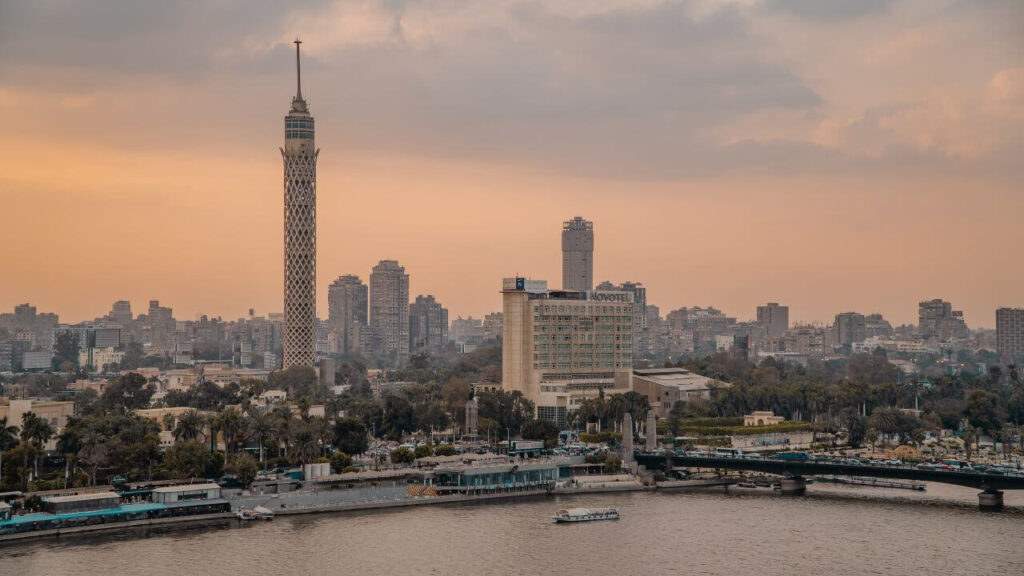
Brief History
Cairo’s rich tapestry of history stretches back over a millennium, having been founded in 969 CE by the Fatimid dynasty, but the area’s human history goes back much further to ancient Egypt. The city served as the center of numerous empires, witnessing the rise and fall of different civilizations and standing the test of time. Notably, it became an epicenter of learning, culture, and theology.
Is it safe to travel to Cairo?
Egypt, like many other tourist destinations, has areas that are generally safe for travelers as well as areas that are advisable to avoid. The major tourist sites like Cairo, Alexandria, the Nile Delta, and the tourist cities along the Nile River, as well as the beach resorts of Hurghada and Sharm El Sheikh, usually experience high levels of security, and the Egyptian government has a vested interest in keeping these areas safe for tourists. However, there are also regions, particularly in North Sinai, that have experienced significant unrest and are generally considered unsafe for travelers.
Advice from us is to consider purchasing comprehensive travel insurance that covers health, travel disruptions, and theft.
Here are the most popular 30 Things to Do in Cairo:
The Pyramids of Giza- First on the List Things to Do in Cairo
Embark on an epic journey back in time as you visit the awe-inspiring Pyramids and the Sphinx of Giza, monumental testaments to ancient Egypt’s grandeur. Here’s what every traveler needs to know for this unforgettable excursion:
Preparation
- Buy a ticket. If you are traveling solo, you need to buy a ticket. If you are traveling with a tour guide and a group, the travel agency or the tour guide will provide a ticket for you.
- Begin early or late in the day to avoid the desert’s peak heat, and ensure you’re equipped with water, sunblock, and comfortable walking shoes.
- Consider hiring a knowledgeable guide for insightful historical context and assistance navigating the expansive site.
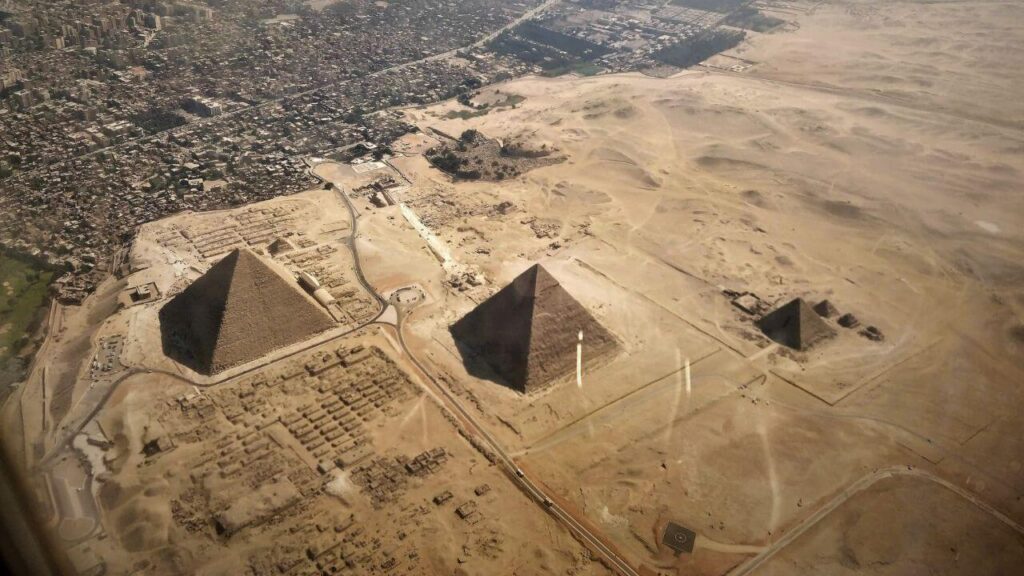
The Experience
- Stepping onto the Giza Plateau, you’re instantly transported back in time, the magnificent Pyramids of Giza dominating the horizon. The sheer scale of these structures, particularly the Great Pyramid, one of the Seven Wonders of the Ancient World, is humbling.
- The mysterious Sphinx, an iconic symbol of Egypt, sits in stoic silence nearby, guarding the pyramids with its lion’s body and pharaoh’s face. Its enigmatic gaze has fascinated travelers for millennia.
- The panoramic vista of the desert expanse, with the contrast of Cairo’s cityscape in the distance, offers a surreal blend of the ancient and modern worlds.
What to Bring
- Protective gear like a hat and sunglasses are essential under the Egyptian sun, along with a camera to capture these iconic structures.
- Small cash is handy for tickets and any souvenirs from local vendors.
Safety
- Stick to designated visitor paths and respect all safety signs and instructions, preserving the integrity of these ancient sites.
- Beware of scammers or aggressive vendors; interacting with registered guides or staff is advisable.
Visiting the Pyramids and the Sphinx is not just sightseeing; it’s an immersive dive into the depths of human history. This experience, replete with architectural marvels and remnants of an ancient world, leaves travelers with a profound sense of awe and respect for one of humanity’s greatest civilizations. As you leave, the images and emotions evoked by these ancient wonders will leave an indelible imprint upon your memory.
The Egyptian Museum
Prepare to be enthralled as you step into the world of ancient Egypt, all within the walls of the iconic Egyptian Museum in Cairo. Here’s a concise guide for travelers seeking to unravel the mysteries of a bygone era:
Preparation
- Plan to arrive early to avoid large crowds and give yourself ample time to explore, as the museum’s vast collection can easily fill several hours.
- Keep in mind the museum’s rules: photography may be restricted within certain exhibits, and large bags might need to be checked in at the entrance.
The Experience
- Upon entering, you’re greeted by an impressive collection of artifacts that span the entirety of ancient Egyptian history. Every exhibit links to the past, from the Old Kingdom to the Greco-Roman period.
- The golden treasures from the tomb of Tutankhamun are a highlight, gleaming as if they were crafted yesterday. You can’t help but feel a shiver down your spine as you meet the famous death mask’s serene, enigmatic gaze.
- Statues, carvings, mummies, jewelry, and even royal chariots surround you, each piece pulling you deeper into ancient Egyptians’ daily lives, beliefs, and practices.
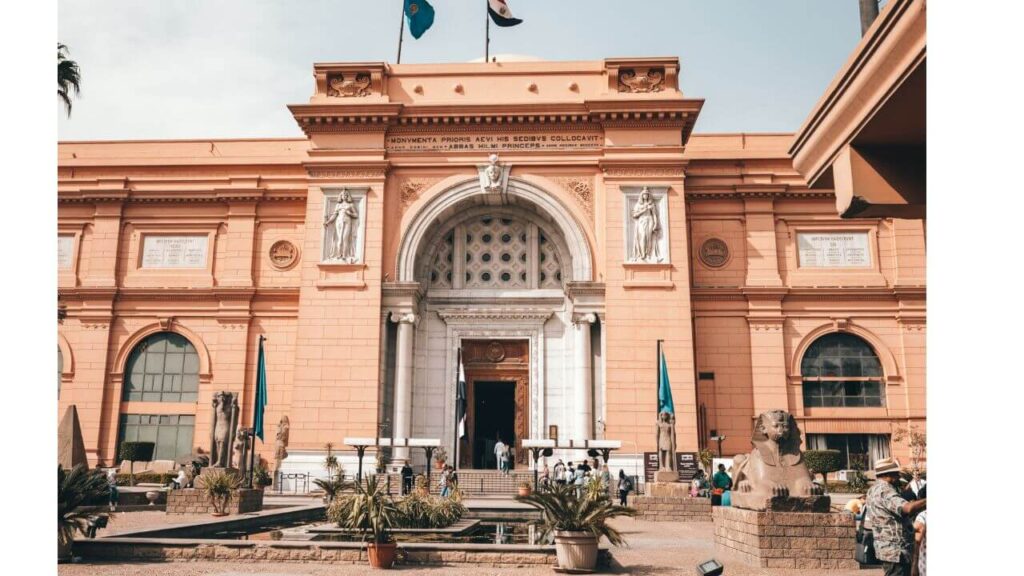
What to Bring
- A guidebook or audio guide can greatly enhance your understanding of the exhibits, providing context that brings the artifacts to life.
- Carry some cash, as some exhibits may require an additional fee and there’s also a gift shop for souvenirs.
Safety
Stick to the museum’s guidelines for a hassle-free visit, and keep an eye on your personal belongings at all times.
A visit to the Egyptian Museum is like walking through the pages of history. With every step, you’re transported further back in time until you’re standing face to face with the individuals who shaped human civilization. Exiting through its grand doors, you carry with you not just memories but stories of a world that has long ceased to continue yet to fascinate and inspire.
Khan el-Khalili Bazaar
On the list of things to do in Cairo, you should put Khan el-Khalili Bazaar. Step into the pulsating heart of Cairo as you enter Khan el-Khalili, one of the world’s most vibrant and historic marketplaces. Here’s what travelers should know before immersing themselves in this colorful labyrinth:
Preparation
- Dress modestly to respect local customs, and ensure you have comfortable footwear, as the bazaar involves a lot of walking.
- Bring cash in local currency (Egyptian Pounds), as many vendors don’t accept cards, and be prepared to haggle—it’s part of the experience!
The Experience
- As you meander through the narrow, cobbled alleyways, your senses are instantly engulfed by the bazaar’s bustling energy. The air is perfumed with exotic spices, and the sound of merchants’ calls mingles with the clinking of copper and the soft rustle of textiles.
- The kaleidoscope of items on display is dizzying—handcrafted jewelry, intricately woven carpets, brass lamps, and an array of colorful scarves are just a fraction of what’s on offer. Each turn brings a new assortment of goods, a testament to the rich cultural tapestry of Egypt.
- Don’t miss the chance to pause at one of the traditional coffee shops. Sipping a strong, flavorful coffee or a refreshing hibiscus tea allows you to soak in the atmosphere. The flavorful aroma of shisha might entice you as the local patrons engage in animated conversations around you.
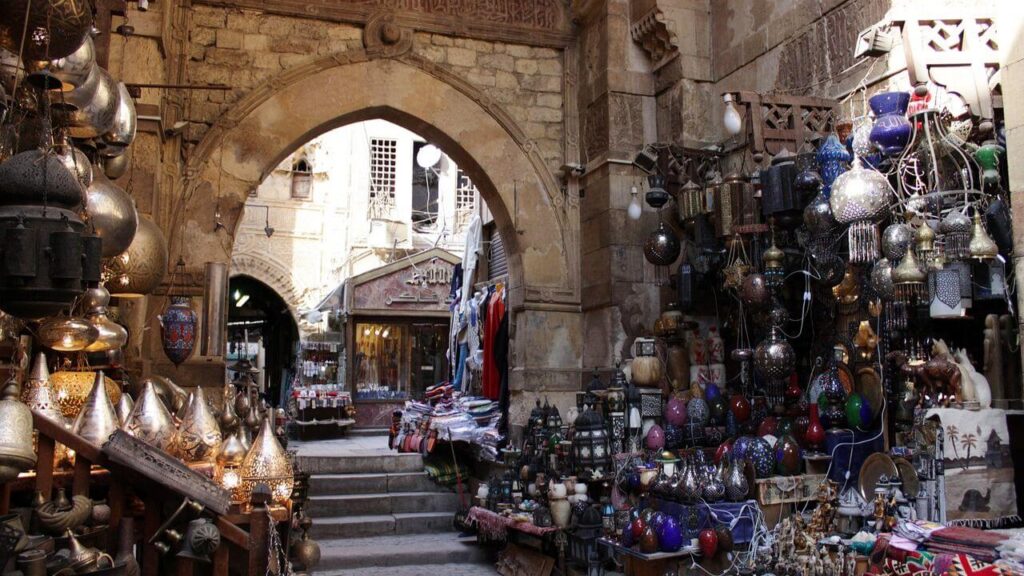
What to Bring
- Keep your belongings secure and within reach, as the crowded market is a prime spot for pickpockets.
- A water bottle is a good idea to stay hydrated, especially during the hotter months.
Safety
- The bazaar is generally safe, but it’s wise to be wary of scams. If a deal seems too good to be true, it probably is. Stick to purchasing from reputable sellers.
Khan el-Khalili isn’t just a market; it’s a living, breathing slice of Egyptian culture. As you step out of its winding pathways back into the modern world, you’ll be leaving with more than just souvenirs. You’ll carry with you the sounds, smells, and spirit of a place where commerce, tradition, and community intertwine to create an experience as timeless as Cairo itself.
Islamic Cairo
Prepare to traverse time as you enter Islamic Cairo, a district steeped in history and brimming with architectural wonders from the Islamic world. Here’s what travelers should know as they embark on this journey through a living museum:
Preparation
- Dress conservatively, covering shoulders and legs, to respect the religious norms, given the numerous mosques in the area.
- Plan your route or consider hiring a local guide, as Islamic Cairo’s maze of streets can be confusing.
The Experience
- Walking the labyrinthine streets, you’re enveloped by the echoes of the past, with the calls to prayer providing a poignant soundtrack to your explorations. The aged, narrow alleys are flanked by grand Islamic structures, with their distinctive domes and minarets piercing the skyline, while the walls tell tales of the bygone era.
- The majestic Mosque of Muhammad Ali is unmissable, its alabaster walls gleaming in the Egyptian sun. Inside, the mosque is a haven of peace, with soft carpets underfoot and a forest of slender, marbled columns surrounding you. The courtyard offers a panoramic view of the city sprawling below.
- Nearby, the bustling market streets around Al-Azhar Mosque, one of the oldest and most prestigious Islamic universities, offer a vibrant contrast. Here, locals and tourists alike seek out treasures from spices to perfumes, and the air is thick with the tantalizing aromas of street food.
- Don’t miss the chance to climb to the rooftop of Bab Zuweila, one of the remaining southern gates, where you can enjoy an uninterrupted view of the old district.
We will go deeper into these amazing structures from Islamic Cairo a bit later.
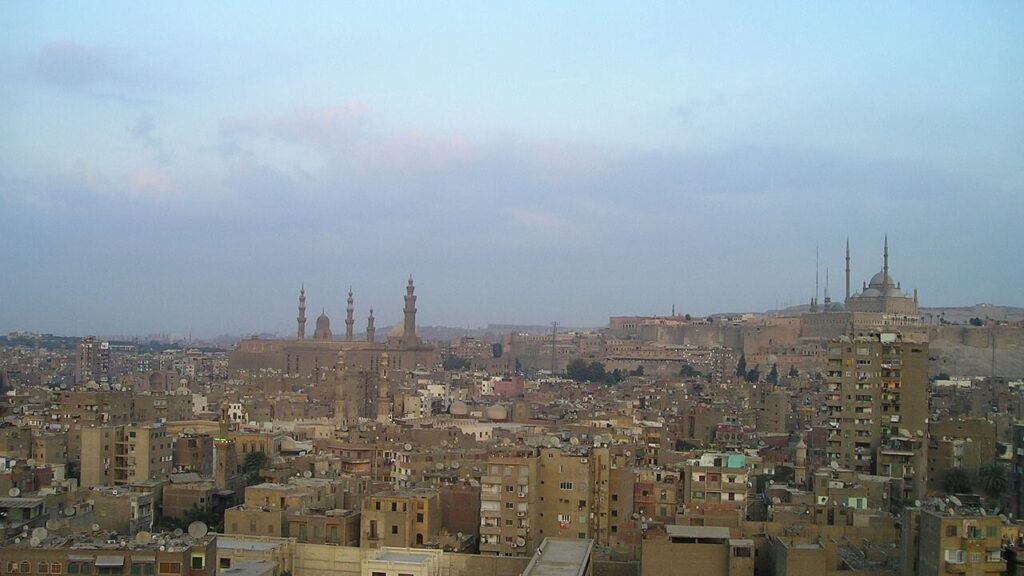
What to Bring
- Comfortable shoes are a must, as the area is best explored on foot.
- Keep some cash handy for entrance fees to certain monuments or for spontaneous purchases in the bazaars.
Safety
Be mindful of the busy traffic and keep an eye on your belongings, as crowded areas can attract pickpockets.
Islamic Cairo is a journey for the soul, offering a glimpse into the lives that have thrived within its walls over the centuries. It’s a place where every corner holds a story, every call to prayer has a note of timeless longing, and the past feels forever intertwined with the present. You’ll leave with a piece of history etched into your memory, a narrative of a resilient and fascinating world.
Salah El Din Citadel
Perched on a spur of the Muqattam Hills, the Salah El Din Citadel dominates Cairo’s skyline, a testament to the city’s rich history. Here’s what travelers need to know before visiting this monumental fortress:
Preparation
- Dress appropriately, keeping in mind the Islamic customs, as the Citadel houses several mosques.
- Plan to spend at least half a day exploring the complex and its museums fully.
The Experience
- As you ascend the hill towards the Citadel, the hustle of Cairo gives way to a sense of ascending through history. The robust walls of the fortress, built by Salah El Din (Saladin) in the 12th century, offer a commanding view of the city below, sprawled out like a timeline of civilization itself.
- Inside, the grandeur of the Mosque of Muhammad Ali, also known as the “Alabaster Mosque,” captivates you. Its Ottoman-style architecture presents a striking contrast against the clear blue sky, and inside, the cavernous, carpeted hall invites quiet reflection beneath its ornate ceiling.
- Venturing further into the Citadel, you encounter a blend of medieval military architecture and modern history, including several museums and the Gawhara Palace, with its intricate décor.
- The cool breeze atop the hill provides respite from the city’s heat, and the panoramic views from the Citadel’s walls are unparalleled, offering a unique perspective of Cairo’s diverse landscape, from the sprawling city to the pyramids in the distance.

What to Bring
- A camera is essential for capturing the stunning views and architectural details.
- A bottle of water and sun protection are advisable, as the area is quite exposed.
Safety
- The Citadel is a popular tourist spot and generally safe, but as with all busy locations, keep your belongings secure.
A visit to the Salah El Din Citadel is a journey through layers of history, culture, and architectural splendor. As you navigate its ancient passageways and gaze over the vast expanse of Cairo below, you’ll feel a profound connection to the legions of people—sultans, soldiers, and common folk—who have lived, worked, and worshiped in this remarkable place.
Cairo Tower- The City from Above
Rising from the heart of Egypt’s bustling capital, the Cairo Tower offers visitors a modern contrast to the city’s ancient wonders. Here’s a brief guide for travelers planning to ascend this iconic landmark:
Preparation
- Purchase your ticket at the entrance. It’s best to visit during clear days for the best visibility, and many recommend the hours just before sunset as the most visually stunning.
- Be prepared for a security check at the entrance.
The Experience
- As you enter the Cairo Tower, you’re greeted by its sleek, mid-century modern design, a testament to the more recent layers of the city’s deep architectural history. The interior, though modest, leads you to high-speed elevators ready to whisk you up to the observation deck.
- Stepping out onto the observation platform, you’re enveloped in a panoramic view that truly captures Cairo’s contrasts: the meandering Nile cuts a verdant path through the heart of the desert city, ancient pyramids grace the horizon, and the modern city buzzes in all directions. The expansive view stretches from the city’s dense urban heart to the quiet desert edges.
- The tower’s lattice design, meant to resemble a lotus plant, casts intricate shadows, and the breeze at this height is a welcome respite from the heat below. A revolving restaurant provides a unique dining experience while enjoying the view.

What to Bring
- Your camera is essential for capturing the 360-degree views.
- A light jacket might be useful, as it can get windy at such heights.
Safety
- The tower is well-maintained, with safety railings and security measures in place. However, it’s always wise to keep an eye on your personal belongings.
The Cairo Tower offers a different perspective, not just in terms of the breathtaking view, but in connecting the city’s past and present. As you gaze out over the scene, there’s a sense of being suspended between epochs, grounded by the vibrant life of the city below and the timeless flow of the Nile.
Coptic Cairo, The Hanging Church- A Testament to Timeless Faith
Nestled in the heart of Old Cairo, the Hanging Church, officially known as the Church of the Virgin Mary, offers visitors a glimpse into the rich tapestry of Egypt’s Christian history. Here’s a concise guide for travelers eager to explore this ancient religious site:
Preparation
- Dress modestly, covering shoulders and knees, in respect to the religious nature of the site.
- Plan your visit during non-service times to freely explore the church and its surroundings.
The Experience
- Approaching the church, you meander through the winding alleyways of Coptic Cairo, an area that feels like a living museum, resonating with centuries of history. The church itself, built atop a Roman fortress, seems to float above you, giving an impression of its namesake “hanging” in the air.
- As you ascend the steps to the entrance, the first thing that strikes you is the church’s beautiful facade, a harmonious blend of Islamic and Coptic architectural styles. Upon entering, the serene atmosphere envelops you, the air rich with the scent of incense and echoes of prayers long past.
- Your eyes are immediately drawn to the intricate wooden screen in front of the sanctuary, adorned with geometric patterns and Coptic icons, behind which lies the main altar. The church’s interior, dimly lit by ornate hanging lamps, showcases an array of religious iconography. At the same time, the worn wooden pews and marble pillars speak to the centuries of faithful who have gathered here.
- Looking down, you see the transparent floor panels revealing ruins of the ancient structures below, a vivid reminder of the layers of history upon which the church stands.

What to Bring
- A camera, without flash, to capture the stunning interior artwork.
- Some small changes for any donations or souvenirs.
Safety
- Coptic Cairo is generally safe, but it’s always wise to be cautious with your belongings, especially in crowded areas.
Visiting the Hanging Church is a journey into the heart of Egypt’s Christian heritage, offering a serene retreat from the bustling city outside. As you step back into the sunlight, the echoes of ancient hymns seem to follow you, a lingering reminder of the timeless faith this sacred space embodies.
Al-Azhar- The Epitome of Islamic Learning
Al-Azhar stands in Cairo’s vibrant Islamic district, a beacon of Islamic scholarship and a key site for higher religious learning. Here’s a succinct guide for travelers seeking to delve into the spiritual and intellectual heart of Cairo:
Preparation
- Dress conservatively to respect the religious and educational atmosphere; this means clothing that covers arms and legs and potentially a headscarf for women.
- Understand that the university areas may have restrictions while the mosque is open to visitors.
The Experience
- As you enter the expansive courtyard, the first thing you notice is the sense of calm that prevails over the usual city hustle. Students of all ages walk briskly by, deep in thought or discussion, while worshippers slowly make their way to perform their prayers.
- The mosque’s interior captivates you instantly with its myriad of intricate Islamic designs and calligraphy adorning the walls and ceiling. The soft light seeping through the ornate windows plays upon the thick carpets, where devotees kneel in quiet contemplation.
- Around you, the air is thick with a sense of history and knowledge. The grand prayer hall, with its high ceilings supported by seemingly endless rows of marble columns, invites you to take a moment to sit and absorb the atmosphere.
- Not just a place of worship, Al-Azhar is a hub of learning. It’s not uncommon to see circles of students gathered around a scholar, deep in discussion. Their passion for knowledge is palpable, making the air hum with intellectual energy.
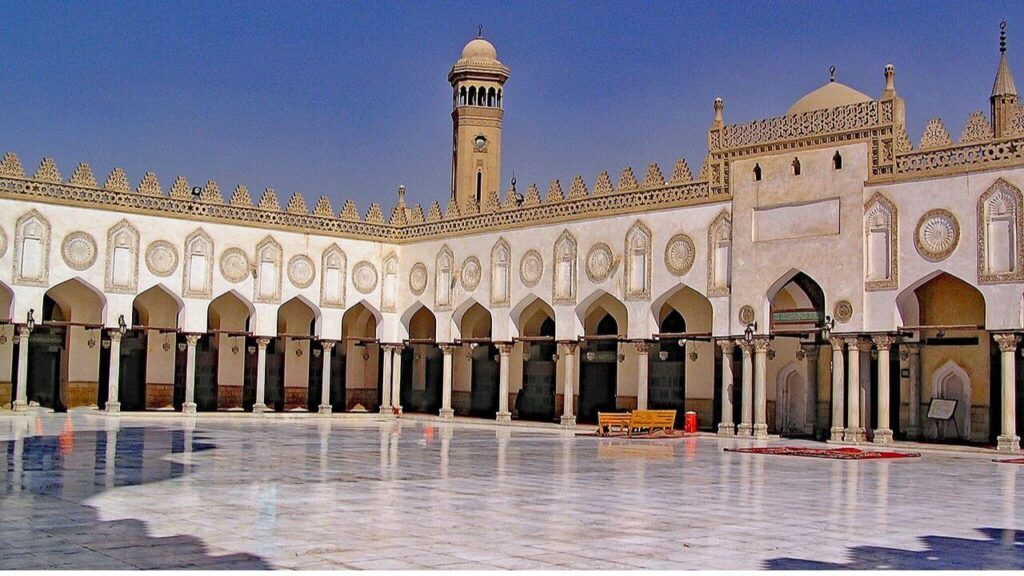
What to Bring
- A camera, but be mindful not to disturb those praying or studying. Flash photography may be prohibited inside the mosque.
- Ensure your phone is on silent, and avoid loud conversations.
Safety
- The area around Al-Azhar is generally safe, but it’s always prudent to keep your belongings secure and be mindful of your surroundings, especially in crowded areas.
Your visit to Al-Azhar isn’t just a step into a religious site but an immersion into a world where faith and intellect have coexisted for centuries. As you leave, the sounds of azan (the call to prayer) and lively scholarly debate fade behind you, but the essence of Al-Azhar’s peaceful pursuit of knowledge stays with you long after.
The National Museum of Egyptian Civilization- A Journey through Time
Another must-visit on the Things to Do in Cairo list is the National Museum of Egyptian Civilization. Dive into the rich tapestry of Egypt’s history at The National Museum of Egyptian Civilization (NMEC), one of Cairo’s cultural gems. Here’s what travelers need to know to appreciate this treasure trove of the past fully:
Preparation
- Check the museum’s opening hours and ticket prices, which may vary for foreign visitors.
- Plan to spend several hours here – the museum’s extensive collections are worth your time.
The Experience
- Stepping inside NMEC, you’re immediately transported through Egypt’s multifaceted epochs, from prehistoric times to present-day culture. The modern, airy space complements the antiquities, providing a serene atmosphere to explore.
- The museum is a visual feast. One of the first exhibits you encounter might be the awe-inspiring royal mummies, each displayed with information about their life and reign. The careful preservation takes you back in time, offering an intimate connection with these ancient rulers.
- As you move through the different galleries, each artifact, from the simplest pottery shard to the most intricate jewelry, tells a story of daily life, royal pomp, religious practices, and artistic expression across the ages.
- Don’t miss the “Eternal Life” exhibit, where the practices and beliefs surrounding death and the afterlife in ancient Egypt are revealed. The artifacts here, especially the mummies and the golden funerary masks, leave an indelible impression.
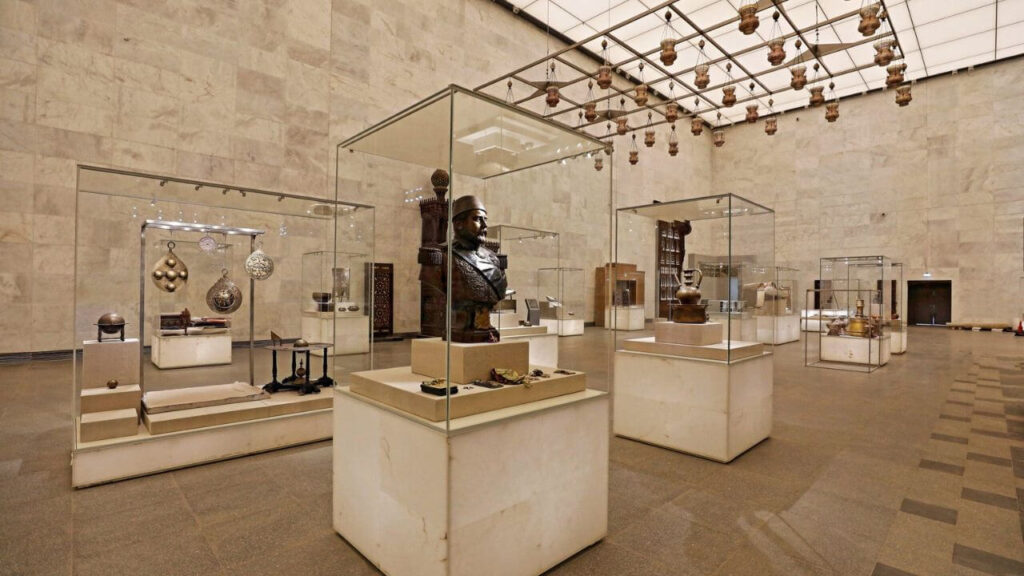
Photo Source the website of NMEC
What to Bring
- A camera without flash. While photography is usually permitted, flash can damage ancient relics.
- Comfortable shoes as you’ll be walking through numerous galleries.
Safety
- The museum is located in a secure area with standard security checks at the entrance. Keep your ticket handy for possible verification inside.
Visiting the NMEC is an opportunity to experience the narratives of an advanced civilization that has profoundly influenced the world. You leave with a sense of wonder, your mind buzzing with the incredible history and the ongoing story of human achievement.
Mosque-Madrassa of Sultan Hassan- A Portal to the Past
Discover the grandeur of Islamic architecture and history at the Mosque-Madrassa of Sultan Hassan, a must-visit destination in Cairo. Here’s a concise guide for travelers:
Preparation
- Remember to dress modestly, covering shoulders and knees, respecting this religious site.
- Check the opening times, as they can vary, especially during Islamic holidays.
The Experience
- Upon entry, your eyes are drawn to the intricate Islamic inscriptions and geometric patterns adorning the walls, a testament to the artistic mastery of the 14th century.
- The courtyard is a haven of tranquility, with the ablution fountain at its heart, a traditional feature of mosque architecture. The expansive area is surrounded by four iwans (vaulted halls), each dedicated to teaching one of the main schools of thought in Sunni Islam.
- The mausoleum holding Sultan Hassan’s remains is an intimate, dimly lit space where the echoes of your footsteps mingle with the whispers of history.
- As you explore, the harmony of form and function in the building’s design becomes evident. It’s not just a place of worship but also a place of learning, with each iwan serving as a classroom for students of the past.

What to Bring
- A camera to capture the stunning architecture (check any photography restrictions onsite).
- Some cash for small donations, as they help with the mosque’s upkeep.
Safety
- This is a place of worship, so be mindful of those who come to pray. Keep noise levels low and avoid interrupting the worshippers.
A visit to the Mosque-Madrassa of Sultan Hassan offers more than a glimpse of the past; it’s a deep dive into the rich tapestry of Islamic art, architecture, and academia. As you step back out into the bustling streets of Cairo, you carry with you a piece of history and a profound sense of the devotion and scholarship that this monumental mosque-madrassa has witnessed over the centuries.
Al-Muizz Li-Din Allah Al-Fatima Street- Walking Through History
Step into the heart of Islamic Cairo on Al-Muizz Li-Din Allah Al-Fatima Street, one of the oldest streets in Cairo, packed with stunning Islamic architecture. Here’s a brief guide for travelers:
Preparation
- Wear comfortable walking shoes; this is a pedestrian street, and there’s much to explore on foot.
- Plan to visit in the early morning or late afternoon when the street is less crowded, and the temperature is cooler.
The Experience
- Walking this street feels like stepping back in time. With every step, you’re walking the same stones that generations have tread for centuries.
- Both sides of the street are flanked by medieval architectural treasures, from ornate mosques and madrassas to grand courtyards and caravanserais. The intricate Islamic art and calligraphy invoke a deep sense of history and culture.
- Various vendors sell traditional crafts, offering a colorful glimpse into local life and customs. The aroma of street food mingles with the scent of aged wood and stone.
- The buzz of the locals bartering, the call to prayer from the minarets above, and the intricate mashrabiya (wooden lattice-work) adoring some of the older buildings make for an immersive cultural experience.
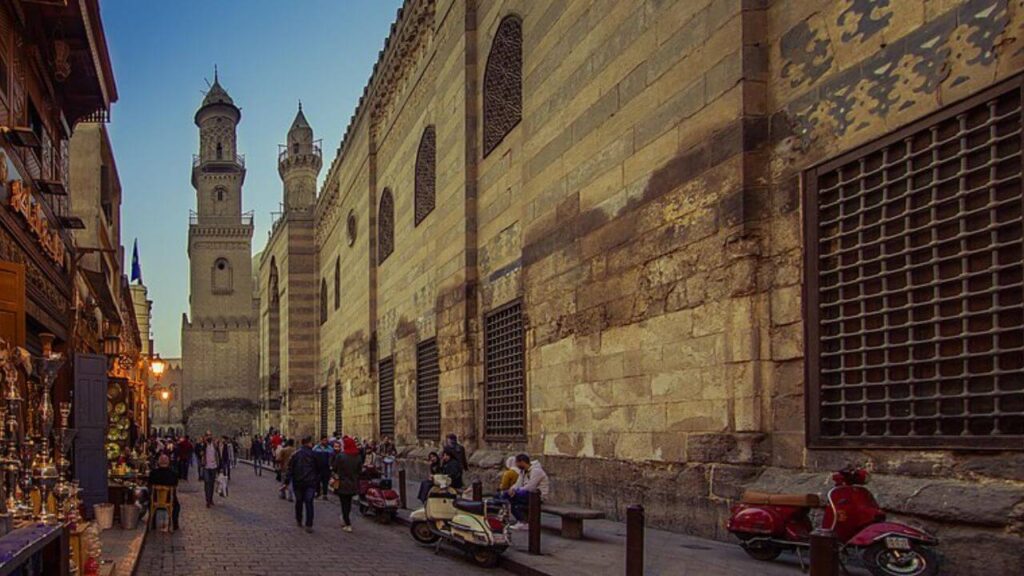
Photo source: Wikimedia Commons
What to Bring
- A camera to capture the historical sites, but be mindful and ask for permission before photographing local people or private property.
- Egyptian pounds (cash), as many smaller shops and vendors don’t accept cards.
Safety
- Keep your belongings secure and be mindful of pickpockets, common in crowded areas.
- Stick to the main street and public areas, and be respectful when photographing residents.
A walk down Al-Muizz Li-Din Allah Al-Fatima Street isn’t just a casual stroll; it’s a journey through the rich tapestry of Islamic history and Egyptian culture. As you leave, the echoes of the muezzin’s call and the visual feast of art and life linger in your mind, a persistent reminder of the vibrant history in this ancient street.
Museum of Islamic Art
Immerse yourself in one of the world’s greatest collections of Islamic art, spanning 1,400 years of history, housed in the Museum of Islamic Art in Cairo. Here’s a brief guide for travelers eager to delve into this treasure trove of culture:
Preparation
- Check the museum’s opening hours and ticket prices before your visit; it’s advisable to arrive early to avoid large tour groups.
- A guided tour can enhance your experience, providing expert insights into the exhibits.
The Experience
- Entering the museum, you’re immediately transported to different epochs of Islamic history. The sheer variety of artifacts, from textiles and carpets to ceramics, jewelry, and intricately designed metalwork, is staggering.
- Marvel at the exquisite craftsmanship of the woodwork displays and the intricate detail in the glass and crystal artifacts. The beautifully preserved manuscripts and Qur’an copies, some dating back to the 7th century, are a particular highlight.
- The atmosphere is reverent and awe as you move from one gallery to the next, each piece telling a story from a civilization’s golden age. The layout leads you through the Islamic world’s different periods and geographic regions, offering a unique perspective on a diverse cultural heritage.
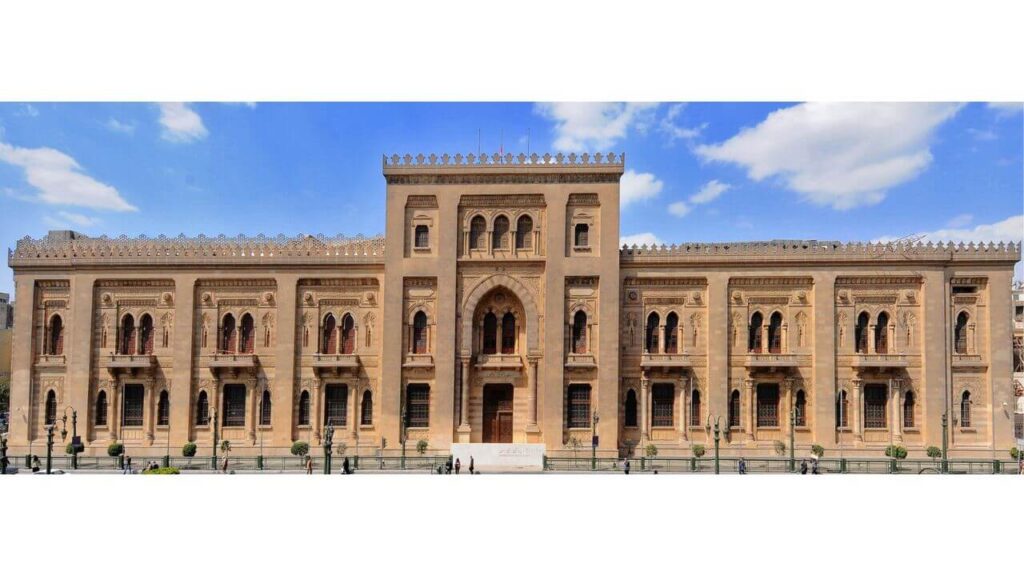
Photo source: Wikipedia
What to Bring
- A camera without a flash is usually permissible, but check the museum’s photography policy.
- Consider a guidebook or the museum’s audio guide to provide detailed information about the exhibits.
Safety
- Keep your belongings close; while the museum is secure, it’s always wise to be cautious with personal items.
- Follow all museum guidelines, particularly regarding photography, food, and touching the exhibits.
A visit to the Museum of Islamic Art is a journey across centuries and continents, offering a glimpse into the rich and diverse world of Islamic heritage. As you step back into the bustling streets of Cairo, you carry with you a deeper appreciation for the artistry, wisdom, and vision that continues to influence civilizations around the globe.
Bab Zuweila
Step through time as you enter Bab Zuweila, one of the last remaining southern gates from the walls of Fatimid Cairo. Here’s what every traveler venturing into this historical landmark should know:
Preparation
- Plan to visit during daylight hours for the best experience and views; the climb to the top is not recommended for those with mobility issues due to steep, narrow steps.
- There’s no entrance fee, but a small donation is appreciated for maintenance.
The Experience
- As you approach Bab Zuweila, you’re struck by its imposing structure, standing resilient through centuries of history. Its robust, fortified appearance, complete with large wooden doors and minarets on each side, offers a striking picture of medieval military architecture.
- Embarking on the steep climb to the top, you’re treated to a labyrinthine journey through Cairo’s history. The higher you climb, the more the modern city falls away, and a panorama of minarets, domes, and bustling streets unfolds.
- From this vantage point, the juxtaposition of time is palpable — ancient mosques and houses dotting the landscape intermingled with contemporary Cairo’s hustle and bustle. The call to prayer, echoing over the rooftops, enhances the timelessness of the scene.
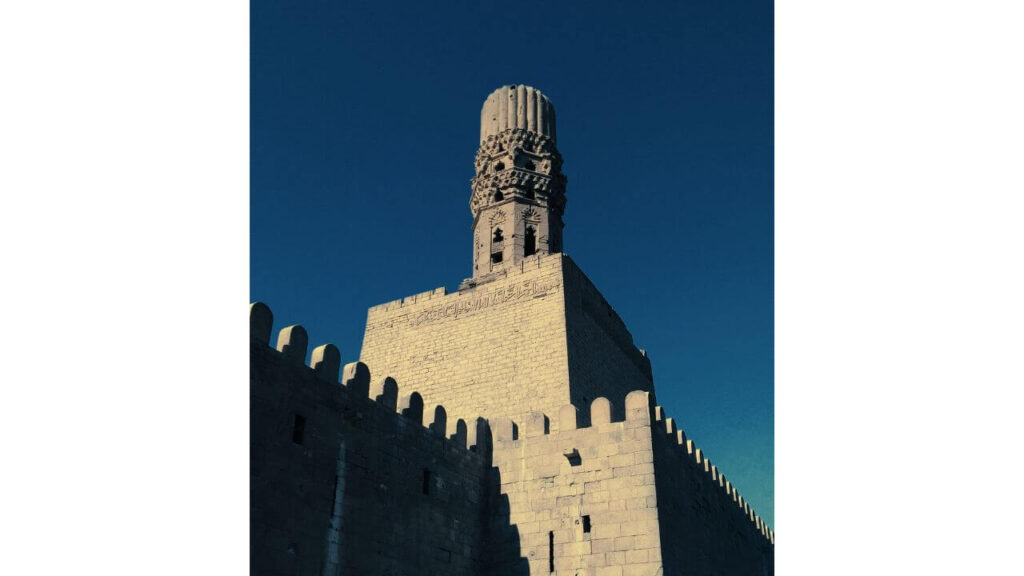
What to Bring
- Good walking shoes are essential for the climb.
- A camera is a must-have to capture the panoramic views.
- A bottle of water — the climb can be exerting, especially in hot weather.
Safety
- Take care when climbing; the steps are steep and can be uneven.
- It’s advisable to keep your personal belongings secure and close to you.
Visiting Bab Zuweilais immerses you in the living history of Cairo. As you descend and step back onto the city streets, you’re returning from a journey that spanned both the physical height of the structure and the depths of Cairo’s rich, historical tapestry.
Church of St. Sergius And Bacchus- Sanctuary of the Holy Family
Dive into the depths of history with a visit to the Church of St. Sergius and Bacchus, known locally as Abu Serga. Here’s a snapshot for travelers eager to explore this iconic religious treasure:
Preparation
- Entry is free, but donations are appreciated.
- Respectful attire is required; cover shoulders and knees.
- Plan to spend at least 30 minutes to an hour for the entire visit.
The Experience
- Stepping into the serene confines of Abu Serga, you’re instantly transported to an era of devout faith and divine sanctity. The church’s subdued lighting and the scent of incense create an atmosphere of reverence and contemplation.
- Your eyes are drawn to the ornate icons, the intricate Coptic art, and the woodwork of the screens, each detail telling a story of its religious heritage.
- Descending into the crypt, the air grows cooler. It’s here, in this small, humble space, that you truly feel the weight of history — this is believed to be a resting place for Jesus, Mary, and Joseph during their flight to Egypt. The atmosphere is palpable with reverence, the silence speaking volumes to those who listen.
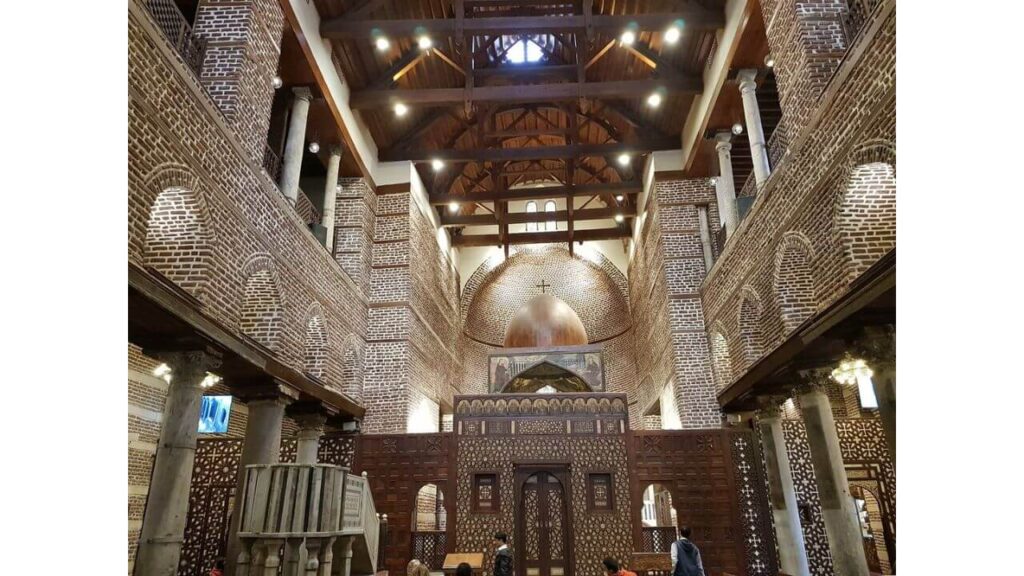
Photo source: Tripadvisor
What to Bring
- A camera (without flash) to capture the interior’s ancient art and architecture.
- A small donation to contribute towards the church’s upkeep.
Safety
- Keep your belongings secure; it’s a safe place, but it’s always wise to be cautious, especially in crowded areas.
- Follow any instructions given by the church staff, especially regarding photography, to respect the sanctity of services and prayers.
Our advice is to put on your must-visit during the Cairo tour. Visiting the Church of St. Sergius and Bacchus, is a pilgrimage back through centuries of faith and devotion. As you retrace your steps back to the bustling streets of Cairo, the echoes of ancient prayers seem to linger in your ears, a serene reminder of the spiritual journey you’ve just undertaken.
The Cave Church- A Spiritual Haven Carved in Stone
Another amazing church on the list of things to do in Cairo. Discover the marvel of human faith and resilience at the Cave Church, the Monastery of Saint Simon. Here’s a brief guide for travelers seeking a unique spiritual and architectural experience:
Preparation
- There’s no entry fee, but donations to the church are welcomed.
- Dress modestly out of respect for the religious setting.
- Allocate at least an hour to experience this sacred space fully.
The Experience
- As you approach, the Cave Church unveils itself like a divine secret, nestled in the Mokattam mountain. The rugged, natural cave walls encircle you, whispering tales of faith’s endurance.
- Entering the church, the sheer magnitude of the cavern space takes your breath away. Carved into the rock itself, this worship place can hold 20,000 people, its stark, simple lines directing your eyes heavenward, instilling a sense of divine awe.
- The detailed religious carvings and biblical scenes come alive on the stone, their stories echoing through the expansive cavity. Natural light filters in, casting a celestial glow that highlights the pulpit and the altar, inviting silent prayer and reflection.
- The atmosphere is peaceful, almost otherworldly—despite the church’s size, there’s an intimate feel, a profound sense of connection to something far greater than oneself.
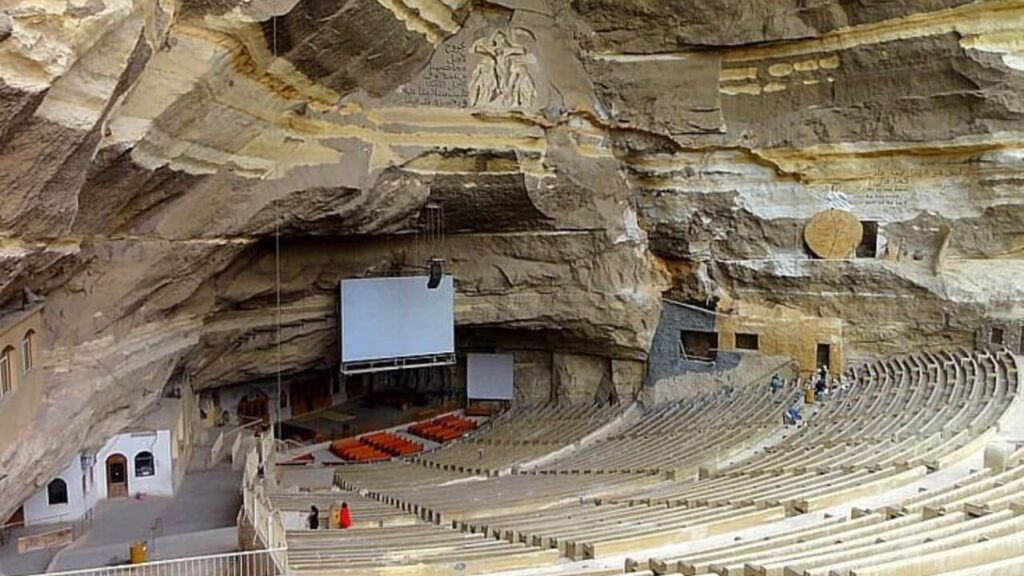
Photo Source: Tripadvisor
What to Bring
- A camera to capture the awe-inspiring interior, but check any restrictions, especially during services.
- Water, especially during hot days, as the area can be quite warm.
Safety
- Follow the guidance of local staff regarding where you may go within the church, especially during services.
- The surrounding area is generally safe, but as with all travel, stay aware of your surroundings.
Visiting the Cave Church is a journey into the heart of human devotion, a testament to the power of faith to carve out a place of worship even in the bare rock. As you step back into the daylight, you’re left with a sense of wonder, the spiritual resonance of the place lingering in your heart and mind.
Manial Palace Museum-Royal Elegance Amid Nature
Step into the world of Egyptian royalty at the Manial Palace Museum. Here’s what travelers need to know for a visit filled with history, art, and nature:
Preparation
- There’s an entry fee, which varies for locals and foreigners.
- Photography inside the museum may require a separate ticket.
- Allocate at least 2-3 hours for a comprehensive visit.
The Experience
- As you enter the Manial Palace grounds, the hustle of Cairo fades, replaced by the serenity of lush gardens and the Nile’s soft ripples nearby.
- The palace complex, built by Prince Mohammed Ali between 1899 and 1929, is an architectural masterpiece, blending Ottoman, Moorish, Persian, and European styles. Each building you approach offers a different historical narrative, told through its unique design and the treasures it houses.
- Inside the main palace, the opulence of the Royal Family is palpable. Each room brims with artifacts, lavish furnishings, and ornate décor, preserved through the decades. The intricacy of the wooden inlays and the vibrancy of the stained glass catches your eye, reflecting the luxurious lifestyle of Egypt’s former ruling class.
- Stepping into the gardens, you’re enveloped in greenery with palm-lined paths and floral scents. The contrast between the palace’s grandeur and the gardens’ natural simplicity is striking, offering a moment of tranquility.

Photo Source: Wikipedia.org
What to Bring
- Comfortable footwear, as you’ll be walking through various buildings and gardens.
- A camera for the breathtaking views and intricate interior designs (remember to check photography permissions).
Safety
- The palace is well-guarded, but keeping your belongings secure is advisable.
- Follow the staff’s instructions and be mindful of the artifacts and exhibits.
Visiting The Manial Palace Museum gives you an immersive experience of the diverse cultural influences that shaped modern Egypt. As you leave, the palace’s elegance and the serenity of its gardens leave a lasting impression, a royal memory etched in your travel story.
Gayer-Anderson Museum- A Journey Through Time and Art
Immerse yourself in the rich tapestry of Egyptian history and art at the Gayer-Anderson Museum. Here’s a brief guide for travelers looking to explore this hidden gem:
Preparation
- There’s a nominal entrance fee, with variations for students and international visitors.
- Photography might be restricted within certain areas; inquire about permissions.
- Allocate about 1-2 hours to appreciate the collections fully.
The Experience
- Nestled at the foot of the Ahmed ibn Tulun Mosque, the Gayer-Anderson Museum, also known as Beit al-Kiritliya, is a mesmerizing blend of two originally separate residences dating back to the 16th and 17th centuries.
- You’re taken on a journey through time when you step within its walls. The museum is named after Major R.G. Gayer-Anderson, a British officer who resided in the house until 1942 and furnished it with an exquisite collection of art, furniture, and rare curiosities from all over the Middle East, the Far East, and Europe.
- Each room unfolds like a chapter from a history book, adorned with intricate Islamic carvings, Persian carpets, and antique furniture that reflect various periods of Egyptian history. The walls echo legends, the artifacts tell stories, and the preserved residential rooms offer a glimpse into the opulent lifestyle of the past.
- Don’t miss the rooftop for a panoramic view of Cairo, especially the majestic silhouette of the Ibn Tulun Mosque’s minaret against the cityscape.
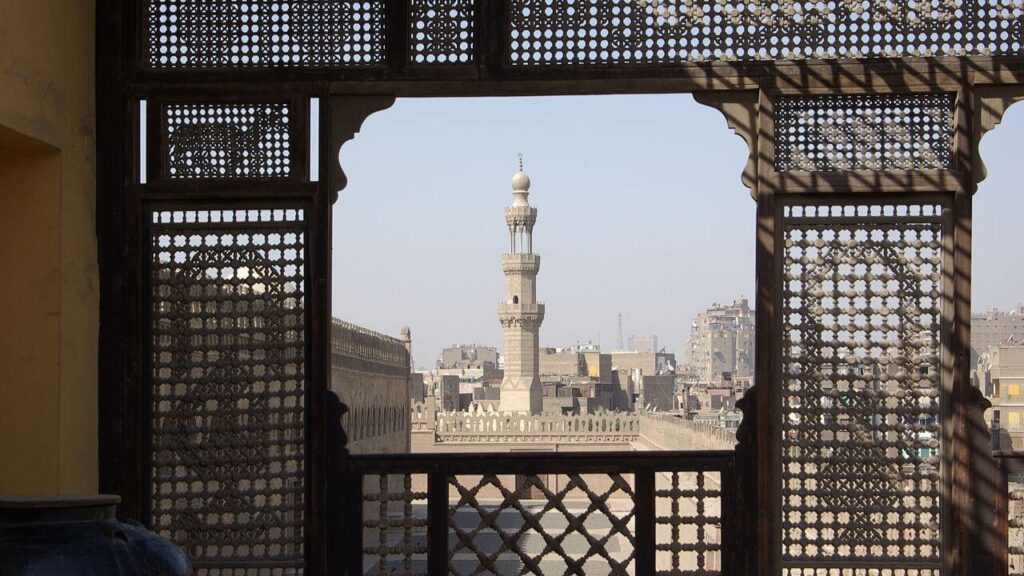
What to Bring
- Wear comfortable shoes as you navigate through numerous rooms and staircases.
- A camera, but remember to adhere to the museum’s photography policy.
Safety
- While the area is secure, keeping your belongings close is always wise.
- Respect the museum’s artifacts; refrain from touching or disturbing the displays.
The Gayer-Anderson Museum isn’t just a museum; it’s a historical experience that paints a vivid picture of diverse eras. You’ll leave with a sense of having traversed continents and centuries, a traveler in history and art.
Al-Azhar Park- Cairo’s Green Serenity
Step into the tranquility of Al-Azhar Park, a lush haven in the heart of Cairo. Here’s what travelers need to know when planning a visit to this peaceful retreat:
Preparation
- There’s an entrance fee, which is minimal, but it contributes to the park’s maintenance.
- Plan 2-3 hours for a leisurely visit, especially if you intend to watch the sunset.
- Restaurants and cafes are available inside for refreshments, though they might be slightly pricier than outside options.
The Experience
- As you enter Al-Azhar Park, the hustle and bustle of Cairo fade into the background, replaced by the serenity of sprawling green lawns, vibrant flower beds, and meandering pathways.
- Located on a hilly site with majestic panoramic views, the park offers a unique view overlooking the city. From here, the juxtaposition of historic Cairo and monumental landmarks against the modern city skyline is breathtaking, significantly as the sun dips behind the city, casting a golden hue over the landscape.
- The park isn’t just about relaxation; it’s a history lesson, too. Developed on a 500-year-old rubbish dump, Al-Azhar Park is now a symbol of successful urban regeneration, offering insights into Cairo’s commitment to ecological and cultural preservation.
- Don’t miss the Ayyubid wall, constructed by Salah El-Din more than 800 years ago, uncovered and restored during the park’s development.
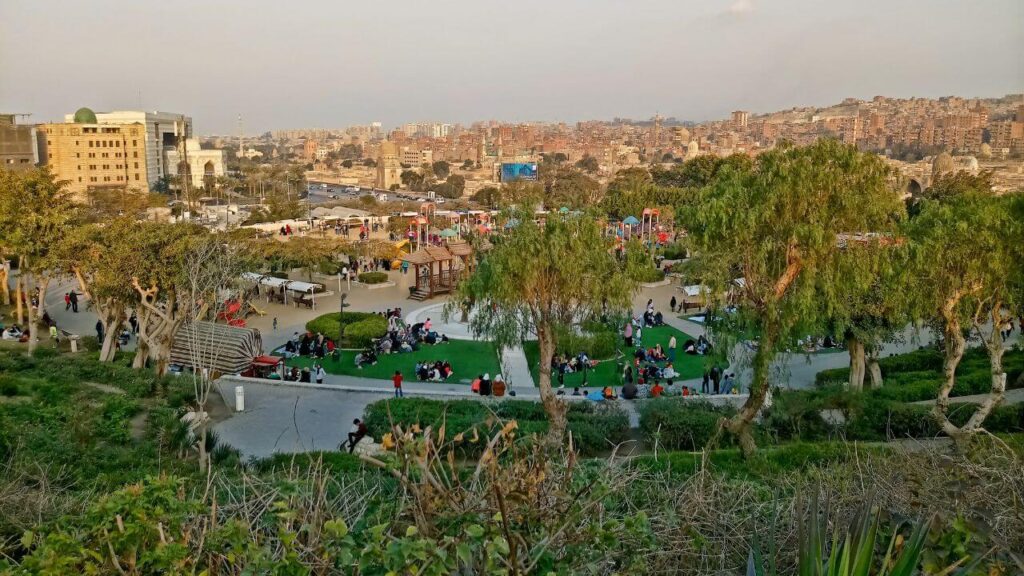
What to Bring
- A camera for the fantastic views.
- Comfortable walking shoes to navigate the vast grounds.
- A light jacket or shawl for cooler evening temperatures.
Safety
- The park is patrolled by security, but as with any public space, keep your belongings secure.
- Stick to the designated paths and areas for your safety, especially in the evenings.
Al-Azhar Park isn’t just a park; it’s a breath of fresh air amid Cairo’s dynamic rhythm, offering a space for relaxation and a balcony to the city’s past and present. Whether you’re there for a stroll, a picnic, or a moment of reflection, you’ll leave feeling refreshed and deeply appreciating Cairo’s multifaceted charm.
Tahrir Square- The Heartbeat of Modern Egyptian History
Immerse yourself in the pulsating core of modern Egyptian history by visiting Tahrir Square. Every traveler needs to know before stepping into this landmark of historical significance.
Preparation
- Be mindful that the square is often busy, being both a tourist attraction and a central location for locals.
- There are no entrance fees, but the surrounding museums and attractions may have them.
- Given its political significance, occasional demonstrations may occur. Stay informed about the current socio-political climate.
The Experience
- Standing in Tahrir Square, you’re at the epicenter of contemporary Egyptian history. This vast expanse became a symbol of Egyptian unity and revolutionary fervor during the 2011 Egyptian Revolution, part of the wider Arab Spring.
- While the square is a bustling hub of traffic and everyday city life, the atmosphere is charged with the invisible yet palpable energy of historical events. You can almost hear the echoes of the chants demanding change and the calls for freedom that once filled the air.
- The area is surrounded by notable buildings, including the Egyptian Museum, the Arab League headquarters, and several important government buildings, making the square a significant landmark beyond its revolutionary reputation.
- The square’s central location makes it a great starting point for exploring other parts of downtown Cairo. The surrounding areas are a vibrant mix of old and new, where street vendors, traditional shops, modern restaurants, and historic buildings coexist.
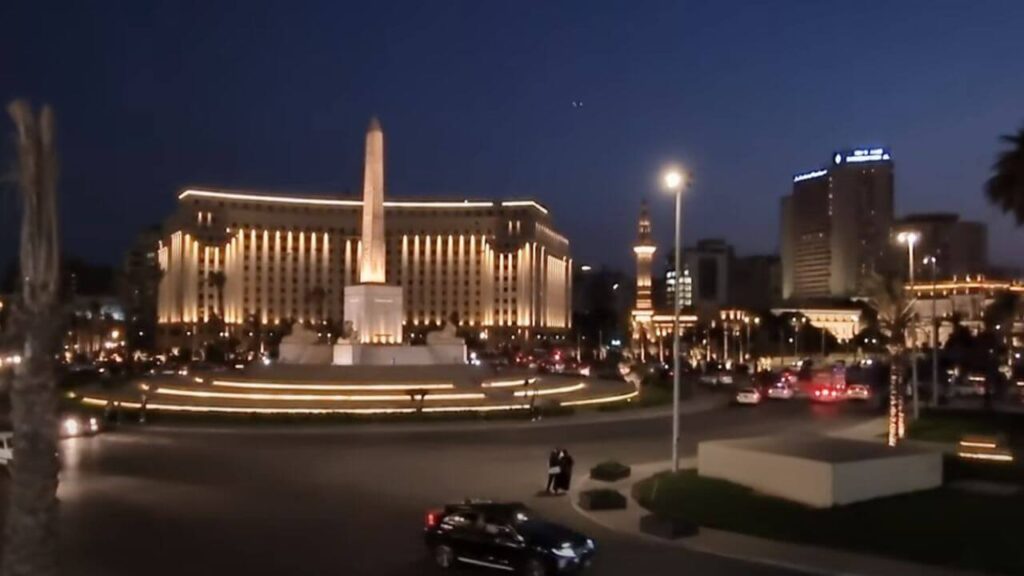
Photo Source: Printscreen from Youtube video.
You can see Tahrir Square at night in this YouTube video:
What to Bring
- A camera, as the square, is part of the fabric of modern Egyptian history.
- Some water and sun protection, as the open area offers little shade.
Safety
- Keep your belongings secure, as with any busy urban area.
- If there’s any sign of gatherings or demonstrations, it’s wise for tourists to keep a safe distance to avoid any unpredictable situations.
Tahrir Square symbolizes resilience, unity, and the dynamic nature of history itself. A visit here offers a deeper understanding of Egypt’s recent past and a glimpse into its vibrant present and unfolding future. Whether you’re people-watching, museum-hopping, or simply soaking in the atmosphere, Tahrir Square is a spot where the pulse of Cairo is tangibly felt.
Abdeen Palace Museum- A Glimpse of Royal Opulence
Step into a world of luxury and history at the Abdeen Palace Museum, Cairo’s jewel of architectural grandeur and cultural heritage. Here’s a brief guide for travelers seeking to immerse themselves in Egypt’s royal past:
Preparation
- Check the opening hours before your visit, as they can vary.
- There is an admission fee, which differs for Egyptians and foreigners.
- Photography may be restricted inside the museum, so be prepared to store your camera if necessary.
The Experience
- As you approach Abdeen Palace, the exterior architecture, a blend of Islamic and European styles, sets the tone for the magnificence within.
- Upon entering, you’re transported into an era of regal extravagance. The palace, once a presidential residence, is now home to multiple museums, showcasing an impressive collection of historical artifacts, including royal relics, gifts from international dignitaries, and a vast assortment of weapons.
- The halls echo with the whispers of the past, where opulent decorations, grand chandeliers, and exquisite furnishings narrate the stories of those who walked these corridors and graced these rooms. Each section of the palace offers a different theme, giving insight into various aspects of royal life and Egyptian history.
- Don’t miss the palace gardens, a lush oasis that contrasts with the city’s hustle and bustle. The meticulously manicured gardens are a testament to the luxurious lifestyles of the palace’s former residents.

Photo Source: Wikipedia.org
What to Bring
- Comfortable shoes, as the museum complex is extensive and requires a fair amount of walking.
- A water bottle to stay hydrated.
Safety
- Follow the rules and regulations of the palace, especially those regarding photography, to avoid any inconvenience.
- Keep your belongings close; while the area is secure, it’s always wise to be mindful of personal items.
A visit to the Abdeen Palace Museum is not just a walk through a museum but a journey through time, offering a rare glimpse into the luxurious lives of Egypt’s rulers from another era. It stands not only as a monument of historical significance but also as an artistic and cultural treasure trove. Whether you’re a history enthusiast, an art lover, or a curious traveler, the palace promises an enriching experience filled with awe and wonder.
Garbage City- A Community of Resilience and Resourcefulness
Venture off the traditional tourist path to Garbage City, a distinctive area in Cairo known for its resourceful Zabbaleen community. Here’s what travelers should know before embarking on this eye-opening journey:
Preparation
- Plan your visit with a local guide or through a reputable tour company, as this area is not typically part of standard tourist itineraries.
- Dress modestly and respectfully, as this is a residential area.
The Experience
- As you enter Garbage City, be prepared for a stark contrast to Cairo’s typical urban scenes. Here, the Zabbaleen, or “garbage people,” have created a unique economy out of recycling waste.
- Walking through the narrow lanes, you’ll see mountains of recyclables sorted meticulously. Despite the name, the streets are relatively clean of debris – most garbage is collected and sorted for recycling purposes.
- The community is a hub of activity, with people of all ages contributing. You’ll witness the incredible ingenuity of the Zabbaleen, who recycle up to 80% of the waste they collect, a rate that challenges modern recycling industries worldwide.
- Amidst the everyday hustle, the spirit of the community is palpable. Their resilience, faith, and sense of community shine beyond the hardships.

Photo source: Wikipedia.org
What to Bring
- A sensitive and open mindset. This is not your typical tourist site; poverty and hardship are realities here.
- Avoid taking photographs without permission. This is not only respectful but also essential in building trust within the community.
Safety
- Stay close to your guide and follow their instructions, as navigating this area can be overwhelming.
- Be mindful of your surroundings and belongings, keeping in mind that this is a densely populated residential area.
Visiting Garbage City is a profound lesson in sustainability, resilience, and community strength in the face of adversity. It challenges perceptions, evokes empathy, and underscores the universal dignity of hard work. As you leave, you’ll carry with you not only a deeper understanding of Cairo’s complexities but also respect and admiration for a community that thrives against all odds.
Madrassa & Mausoleum of Qalaun- A Glimpse into Mamluk Grandeur
Step into the world of Mamluk heritage with a visit to the Madrassa and Mausoleum of Qalaun, nestled in the heart of Cairo. Here’s what travelers need to know to appreciate this historical gem fully:
Preparation
- Dress modestly, considering the religious significance of the site.
- Plan your visit during daylight hours to appreciate the architectural details and intricate artistry.
The Experience
- As you approach the complex, the striking minaret and imposing facade herald the architectural marvels that lie within. Entering the madrassa, or Islamic school, you’re enveloped in a sanctuary of learning and faith that dates back to the 13th century.
- Your eyes will be drawn to the intricate geometric designs and Arabic calligraphy adorning the walls, a testament to the artistry of the Islamic Golden Age. The interplay of light and shadow through the arched windows creates a serene atmosphere, inviting reflection.
- Moving to the mausoleum, the resting place of Sultan Al-Mansur Qalawun, the ambiance shifts to one of reverence. The tomb is an artwork in its own right, with ornate carvings and a sense of solemn tranquility.
- The whole complex, a blend of hospital, school, and tomb, offers a unique insight into the multifaceted social and religious life of the Mamluk era.
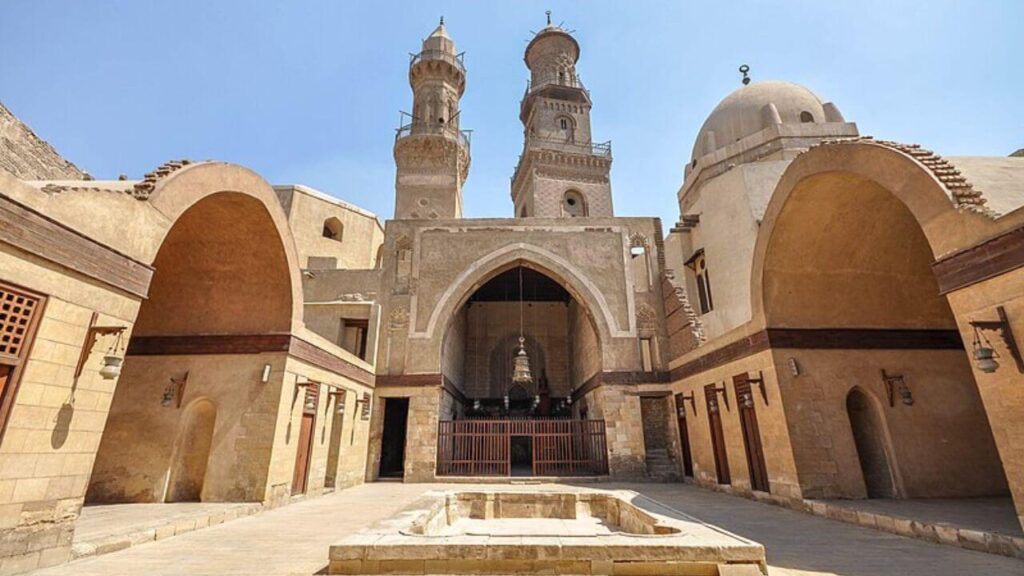
Photo Source: Wikimedia.org
What to Bring
- A camera to capture the stunning Islamic architecture (where permitted).
- Comfortable shoes, as the exploration will involve a fair amount of walking.
Safety
- Respect religious practices and customs, especially if you visit during prayer times.
- Stay aware of your surroundings, as the site is located in a bustling area of the city.
The Madrassa and Mausoleum of Qalaun is not just a journey into the past; it’s an immersive experience into the cultural, religious, and societal foundations of Mamluk society. As you walk the same stone floors that scholars, sultans, and commoners have tread for centuries, you’re reminded of the timeless continuum of history, culture, and human endeavor.
The Qasr El Nil Bridge- Cairo’s Sunset Spectacle
Immerse yourself in the romance and history of Cairo with a stroll across the Qasr El Nil Bridge, a landmark that’s as much a symbol of modern Cairo as the nearby timeless pyramids. Here’s what every traveler needs to savor while experiencing this iconic structure:
Preparation
- Plan your visit around sunset for the most picturesque experience.
- The bridge is pedestrian-friendly, but keep an eye out for cyclists and occasional street vendors.
The Experience
- As you begin your walk across the Qasr El Nil Bridge, the fading sun bathes the city in golden hues, creating a painterly skyline that contrasts beautifully with the Nile’s deep blues.
- The gentle breeze from the river provides a respite from the day’s heat, carrying with it the distant sounds of the bustling city: a blend of car horns, distant music, and the rhythmic ebb and flow of Cairo’s heart.
- Midway across, pause and take in the panoramic views: to one side, the lush greenery of Gezira Island, and to the other, the majestic Nile kissing Cairo’s vibrant cityscape. Below, traditional feluccas sail gracefully, their sails reflecting the sun’s warm glow.
- As the sun dips below the horizon, the bridge lights up, a signal of the city’s never-ending energy and the onset of Cairo’s vibrant nightlife.
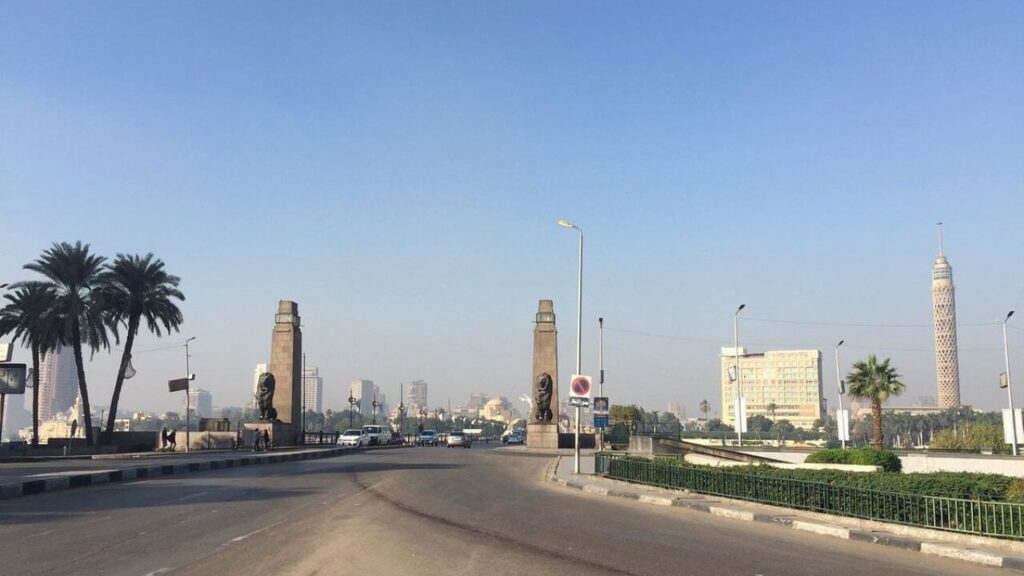
Photo Source: Tripadvisor.com
What to Bring
- A camera or smartphone for those must-capture moments.
- A light jacket or wrap, as it can get breezy over the water, especially after sunset.
Safety
- Keep personal belongings secure and be mindful of traffic when crossing the bridge; the walkways are safe, but it’s a busy area.
- As with many crowded places, it’s wise to be aware of your surroundings and keep an eye out for pickpockets.
A walk across the Qasr El Nil Bridge is more than a simple crossing; it’s a passage through Cairo’s lively culture and scenic beauty. As night falls and you reach the end of the bridge, you’ll carry with you lasting images of a city that blends history, nature, and modernity in a truly unique way.
Day Trip To Dahshur, Memphis, and Saqqara- Time Travel Outside Cairo
Venture beyond the familiar confines of Cairo for a day trip into the heart of ancient Egypt, where the pyramids of Dahshur, the ruins of Memphis, and the necropolis of Saqqara offer a deeper dive into a civilization lost in time. Here’s what every explorer needs to know:
Preparation
- Book a tour or arrange for a private driver, as these sites are spread out and can be challenging to reach via public transport.
- Start early to maximize your day, as there’s much to see and explore.
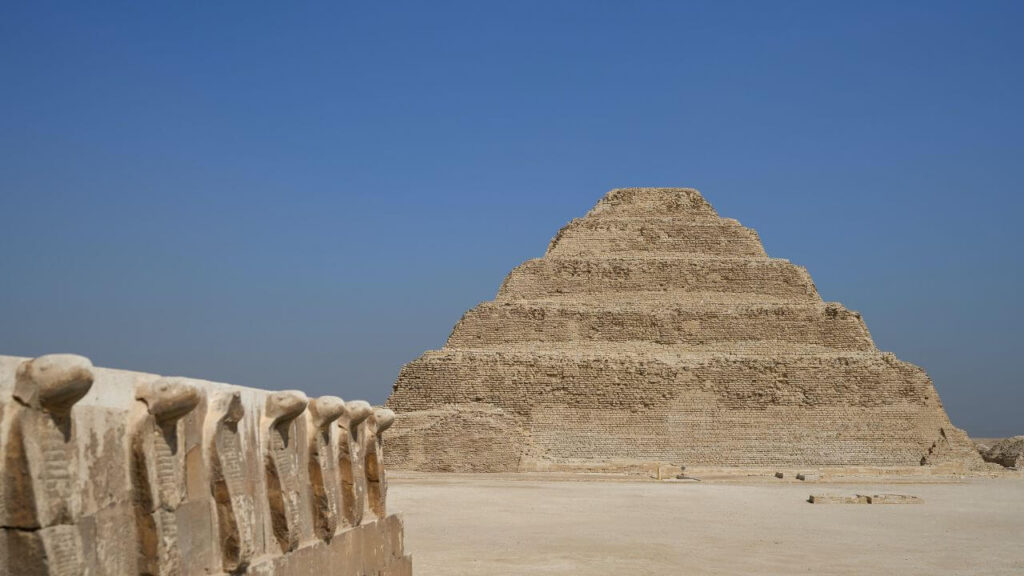
The Experience
- Dahshur: Feel the sands of time beneath your feet as you stand between the Red Pyramid and the Bent Pyramid, ancient engineering marvels. The serenity of Dahshur, free from large tourist crowds, makes your exploration feel like a personal discovery.
- Memphis: Once a thriving capital, now an open-air museum, Memphis invites awe amidst its ruins. The colossal statue of Ramesses II and the Alabaster Sphinx silently narrate the grandeur of what was once a powerful city.
- Saqqara: Home to the Step Pyramid of Djoser, Saqqara is a testament to the evolution of pyramid construction. Wander through the myriad of ancient tombs and imagine the mummification rituals that these walls have witnessed.
What to Bring
- Comfortable footwear is a must, as you’ll be walking on uneven surfaces.
- Sun protection (hat, sunglasses, sunscreen) is vital; these sites offer little shade.
- A bottle of water to stay hydrated and some snacks.
Safety
- Stay with your guide or group; these ancient sites are vast, and it’s easy to wander off and lose your bearings.
- Respect the rules, especially those concerning photography and entering the tombs and pyramids.
A day trip to Dahshur, Memphis, and Saqqara offers more than a glimpse into ancient Egypt; it’s a journey back in time, a personal encounter with the architectural, cultural, and spiritual practices that have shaped history. As the sun sets on your adventure, the images and emotions evoked by these ancient wonders will undoubtedly linger long after you’ve returned to the vibrancy of modern-day Cairo.
Felucca rides
Sailing the Nile in Style
Glide along the Nile’s ancient waters aboard a traditional Felucca, an experience that combines tranquility, history, and stunning views. Here’s what every traveler venturing onto Egypt’s lifeblood should know.
Preparation
- Book your ride through a reputable tour company or your hotel concierge to ensure a fair price and a safe experience.
- Decide on a daytime or sunset sail, each offering unique perspectives of the Nile’s scenery.
The Experience
- Boarding the wooden Felucca, you’ll feel its rich history with every creak of the timber. As the sail hoists, you’re propelled into the gentle rhythms of the Nile.
- The views from the boat are unparalleled: lush riverbanks, the distant outline of cityscapes, and perhaps even locals going about their riverside routines.
- Sunset rides are magical, with the sky’s warm hues reflecting off the water while Cairo’s city lights begin to twinkle in the dusk.
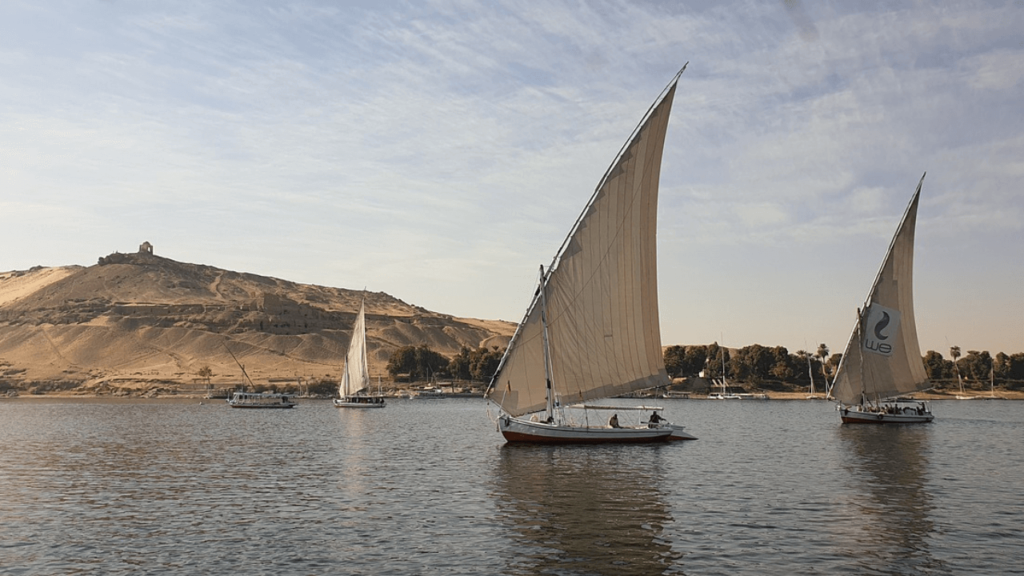
What to Bring
- A light jacket or shawl, as it can get cool on the water after sunset.
- A camera to capture the stunning scenery and unique moments during your ride.
- Cash for tipping your Felucca captain, as it’s customary to offer a gratuity for good service.
Safety
- Listen to your captain’s safety instructions and remain seated during the ride to maintain the boat’s balance.
- Ensure life jackets are available, especially if you’re not a strong swimmer or traveling with children.
A Felucca ride on the Nile is more than just a scenic boat trip; it’s a cultural immersion, offering intimate insights into the enduring relationship between Egyptians and their iconic river. As the sail flutters in the breeze and the water laps gently against the hull, you’ll find it’s not just about the destination but the serene journey along these historic waters. You can find here the complete Nile Cruise Guide.
Ride a Camel at Giza
Embrace the opportunity to experience Egypt’s most iconic historical site in a way that’s as old as the pyramids themselves: by camel! Here’s what every traveler needs to know about this unforgettable adventure:
Preparation
Before you saddle up, it’s crucial to negotiate and agree on the price with the camel operator. Ensure it includes the duration of the ride and any additional stops or services. Hiring a reputable guide through a verified tour operator can often streamline this process and make your experience more enjoyable.
The Experience
Climbing atop a camel, feel the gentle sway as these “ships of the desert” rise gracefully to their feet. With the reins in hand, you’re about to traverse the same ancient sands as pharaohs once did.
As your camel lumbers along the Giza Plateau, the Pyramids of Giza loom large before you, rising majestically against the stark skyline. The largest, the Great Pyramid, is a staggering sight, especially from your elevated vantage point on the camel’s back. You’ll feel transported back in time, with nothing but the sound of the wind and the soft padding of the camel’s feet on the golden sands to accompany you.
To your right, the enigmatic Sphinx, with a lion’s body and a king’s face, guards the plateau, a testament to ancient mysteries still unsolved. Around you, the vast Sahara stretches out, a sea of golden dunes, while the modern city skyline hovers in the distant haze, a stark contrast to the antiquity you’re immersed in.

What to Bring
Ensure you’re dressed comfortably and appropriately for the desert climate; sunglasses, a hat, and sunblock are essential. Bring a bottle of water to stay hydrated, and don’t forget your camera – this ride offers unparalleled photo opportunities!
Safety
Listen to your guide’s instructions for safely mounting and dismounting the camel, and hold on tight when it stands up or sits down, as the motion can be quite sudden.
Try Local Dishes- A Taste of Egypt
When in Cairo, immerse yourself in the rich tapestry of tastes and aromas that define Egyptian cuisine. Here’s a guide to savoring the local culinary delights:
Preparation
- Venture into the heart of the city, where street food vendors and traditional restaurants abound.
- Seek recommendations from locals or your hotel for the most authentic dining spots.
The Experience
- Starts with Koshari, a quintessential Egyptian dish. Watch as layers of rice, macaroni, and lentils are topped with a spiced tomato sauce, garnished with crispy fried onions, and served with side options of garlic vinegar and chili sauce.
- Savor the simplicity of Ful Medames, a fava bean stew often considered the national dish. Taste the beans’ earthiness, complemented by a squeeze of lemon juice, a drizzle of olive oil, and a sprinkling of cumin.
- Bite into Ta’ameya, Egypt’s version of falafel, typically made with fava beans for a green interior and a unique flavor profile. Its crispy exterior gives way to a soft, flavorful center that speaks to generations of culinary tradition.

Exploring Egyptian cuisine is a journey through the country’s history, culture, and soul. Each dish offers more than sustenance; it’s a story of tradition, a tale of Egypt’s diverse cultural influences, and a testament to its people’s love for hearty, flavorful food. As you navigate through Cairo’s bustling streets, let your taste buds guide you, and don’t be afraid to try something new. The city’s culinary delights are sure to leave a lasting impression on both your heart and palate.
Sound & Light Show at the Pyramids- A Night of Enchantment
As the sun sets on the Giza Plateau, the night comes alive with the spectacular Sound & Light Show at the Pyramids, a must-see for every traveler. Here’s what you need to know for this magical experience:
Preparation
- Purchase your tickets in advance as the show is popular and can sell out. There are various language options, so ensure your selection matches your preference.
- Arrive early to secure good seats, as the seating area is on a first-come, first-served basis.
The Experience
- Feel the excitement build as darkness descends, and the crowd hushes in anticipation. Then, the show begins, and brilliant lights illuminate the pyramids and the Sphinx in vibrant colors, visible from your vantage point in the seating area.
- Listen to the spellbinding narration, an imaginative storytelling that brings to life the history and mysteries of the ancient Egyptians. The booming voice of the Sphinx, the ‘Father of Terror,’ is particularly awe-inspiring as it recounts the country’s illustrious past.
- Watch the laser lights dancing across the ancient stones, complementing the dramatic storytelling with visual splendor. The contrast of the night and the radiant display adds a mystical quality to the magnificent structures.
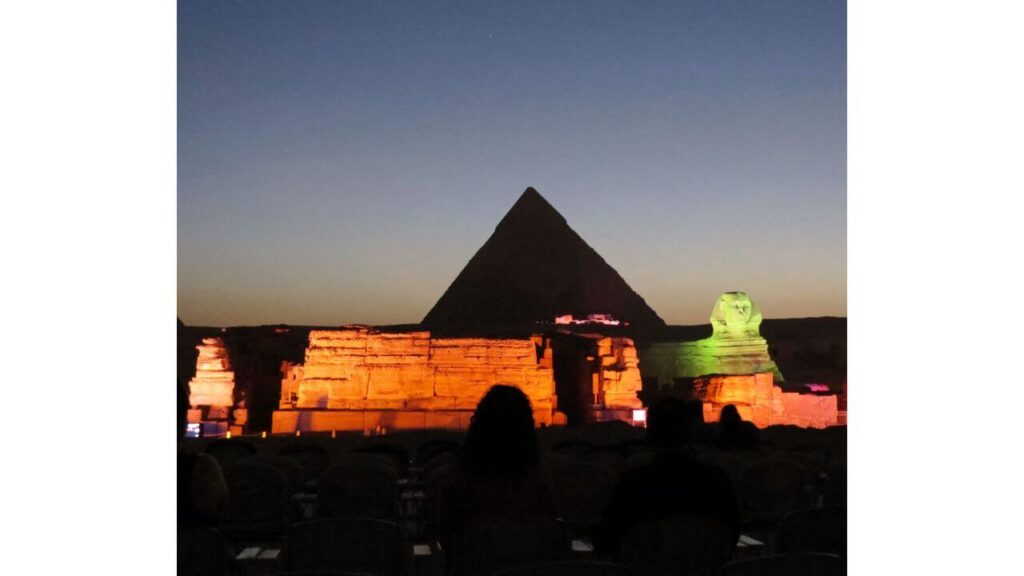
What to Bring
- Dress in layers, as the desert can be hot during the day and chilly at night.
- Bring a camera to capture the stunning light display, but remember, video recording may not be allowed.
Safety
- Stay within the designated areas and follow the staff’s instructions, as the site is a protected World Heritage location.
- Keep personal belongings close, as popular tourist events can attract pickpockets.
The Sound & Light Show at the Pyramids is not just an entertaining display but a transcendental experience, connecting you to the civilization that built these wonders of the ancient world. As the lights dim and the crowd disperses, you’re left with a sense of having witnessed something truly magical, carrying with you memories that will last a lifetime.
Attend a Performance at the Cairo Opera House- An Evening of Cultural Brilliance
Stepping into Egypt’s paramount performing arts venue, the Cairo Opera House is an experience no traveler should miss. Here’s what you need to know to enjoy an evening of exquisite cultural immersion fully:
Preparation
- Check the schedule in advance to choose a performance that piques your interest, be it opera, ballet, symphonic music, or traditional art.
- Purchase your tickets ahead of time either online or at the box office, as shows often sell out, especially high-profile performances.
- Dress smartly, as you’re attending a sophisticated venue; evening attire is recommended for night performances.

The Experience
- As you approach the Opera House, located on the southern tip of Gezira Island in the Nile River, you’re greeted by its modern architectural elegance, which stands out in striking contrast to the historical ambiance of Cairo.
- Inside, the grandeur of the main hall envelops you with its plush seating and stellar acoustics. The anticipation builds as the audience quiets down with the dimming of the lights.
- The curtain rises, and you’re treated to a world-class performance showcasing Egypt’s rich cultural tapestry and the prowess of international artistry. Whether it’s the haunting arias of an opera, the expressive pas de deux of a ballet, the rousing crescendo of an orchestra, or the rhythmic beat of traditional dance, the experience is nothing short of mesmerizing.
What to Bring
- Bring your ID or passport, as you might need to identify yourself when collecting your tickets.
- Have some cash at hand for refreshments during intermissions or any souvenirs you might want from the gift shop.
Safety
- Arrive a bit early to avoid the last-minute rush and to navigate through security checks calmly, ensuring a seamless entry.
- Keep your belongings close and be mindful of etiquette inside the theater, including turning off your mobile devices before the performance begins.
Attending a performance at the Cairo Opera House will undoubtedly be a highlight of your trip, offering a taste of modern Egypt’s sophisticated and diverse cultural scene. As you step out under the starry Cairo night, the melodies and rhythms of the night’s performance will resonate, leaving you with enduring memories of a splendid evening.
Explore the City of the Dead (Qarafa)- Where History Sleeps and Life Thrives
Venturing into Cairo’s City of the Dead, a sprawling necropolis with a living community, is like stepping through a historical panorama. Here’s what travelers need to know for this profound journey:
Preparation
- Plan your visit during daylight hours and preferably in the cooler months to avoid the desert heat.
- Hiring a knowledgeable local guide is highly recommended, as they’ll provide invaluable historical insights, ensure respectful interaction with the residents, and help navigate this extensive area.
The Experience
- As you enter the City of the Dead, you’re immediately struck by its duality: it’s a vast, ancient cemetery, yet also a vibrant community. Centuries-old mausoleums line the pathways, with some structures dating back to the Mamluk period, their intricate carvings speaking volumes of a bygone era.
- Moving deeper, you’ll see that life here blossoms in a most unexpected place: children play in the narrow alleys, laundry hangs between tombstones, and the scent of home-cooked meals wafts through the air. It’s a humbling testament to the resilience and adaptability of the human spirit.
- Among the tombs, many of which resemble small houses, you might find families who’ve made these serene quarters their homes, offering a wave or a friendly smile as you pass by.
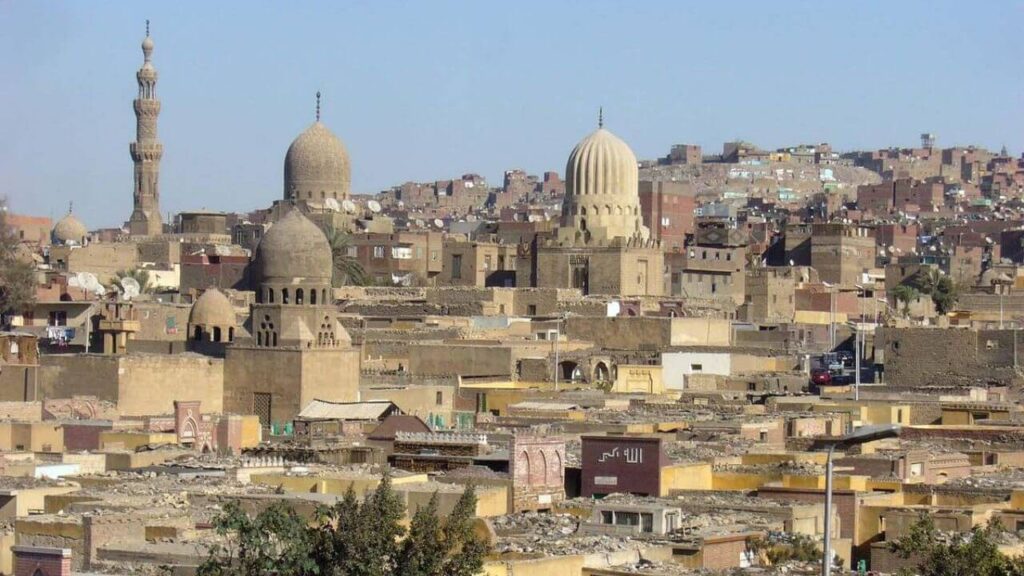
Photo Source: Tripadvisor.com
What to Bring
- Dress modestly out of respect for the residents and the cultural setting.
- Carry water to stay hydrated, and consider bringing small souvenirs or school supplies as gifts for the local families if your guide suggests it’s appropriate.
Safety
- Follow your guide’s lead on where to go; this is both a historical site and a residential area, so respect for privacy and local norms is crucial.
- As always, be vigilant with your belongings and mindful of the community’s day-to-day activities without intruding.
Exploring the City of the Dead is an experience that defies expectation, challenging perceptions of life and death, decay, and vitality. It’s not just a journey through Cairo’s rich history but also an intimate glimpse into a unique, living community. As you leave, you carry with you not just photographs of historic tombs, but poignant images of life thriving amidst them.
How many days do you need in Cairo?
A typical stay in Cairo, Egypt’s historic capital, spans 3 to 4 days. This timeframe suits those keen to explore the city’s major attractions without rushing while also soaking in its vibrant culture.
The city’s ancient sites are grand and numerous, with each requiring at least half a day to explore comprehensively — more if you include the travel time amidst Cairo’s notorious traffic. The landmarks aren’t just about checking boxes; they’re about delving into Egypt’s rich, multifaceted history. Therefore, rushing through them would mean missing out on understanding Cairo’s layers of civilization.
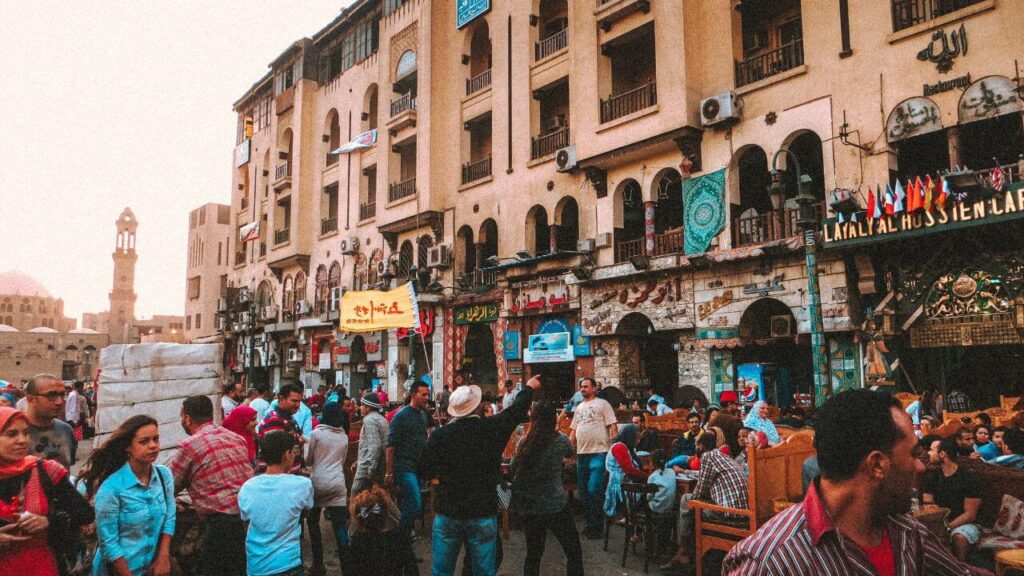
A single day is often dedicated to the iconic Giza Plateau due to its scale and the cultural significance of the pyramids and the Sphinx. Another day usually goes to the Egyptian Museum, a treasure trove of artifacts, where one can spend hours uncovering the past. Additional time is typically spent navigating the city’s diverse districts, historic mosques, and lively markets, all integral to the authentic Cairo experience.
However, these are just guidelines on Top things to do in Cairo. Some visitors, intrigued by the city’s depth, opt for a longer stay of up to a week, allowing for a more relaxed exploration or including nearby destinations in their itinerary. Conversely, those with limited time can focus on the highlights, crafting a condensed experience over 1-2 days.
In essence, Cairo is a tapestry of human civilization, and the time it takes to explore it is subjective, hinging on individual interests and travel preferences. But generally, 3 to 4 days balance a meaningful journey through its wonders and an introduction to its cultural heartbeat.




